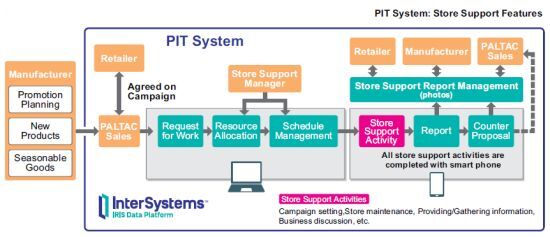
CUSTOMER: PALTAC Corporation
CHALLENGE: Adopt a system infrastructure to enable digital transformation to increase revenues and improve efficiencies.
OUTCOME: InterSystems IRIS data platform is the mainstay of PALTAC’s digital transformation efforts and was used to develop the PIT in-store support application, the first step in that digital shift.
As Japan’s largest wholesaler of cosmetics, daily necessities, and over-the-counter pharmaceuticals, PALTAC plays an indispensable role in moving 50,000 items from 1,000 manufacturers to 400 retailers operating 50,000 stores, when and where they’re needed. PALTAC has long focused on internal development work — which accounts for 70% of all its information systems — to give its supply chain capabilities a competitive edge.
PALTAC’S expansion, coupled with Japan’s persistent labor shortages, made it difficult for the company to move nimbly. Its management plan is aimed at improving productivity throughout the entire production, distribution, and sales supply chain, and increasing revenues at the point where products are delivered to consumers — the retail sales floor.
To this end, PALTAC revamped its sales organization and created the Store Support Division, which is actively involved in setting up merchandising campaigns and promoting new, seasonal, and priority products in stores quickly and effectively. It also launched an initiative to collaborate with manufacturers and retailers in order to accelerate and streamline productivity improvements throughout the entire supply chain, centered on an internally developed application called the PALTAC Innovation Technology System for Field Merchandising (PIT).
Streamlining the Customer Experience
InterSystems IRIS® data platform was selected as the core technology for digital transformation at PALTAC, and the PIT application represents the first phase of that shift. Development of the PIT system began in a Linux environment on Amazon Web Services. The first phase of development was completed four months later, and PIT went live the following month. The application has since been installed throughout the 800-member sales department and is being used by 240 people in the Store Support Division.
PIT is available as both a desktop application and a smartphone app, so PALTAC’s Store Support Division project leaders can use it to assign work and communicate with team members in the field. At the retail sites, team members use PIT on their phones to share and review promotional plans and materials, and they can take photos and record voice and text notes to document their observations and insights. Their reports can be synced with the PIT system via the smartphone app and shared within the sales department and with PALTAC Store Support Division managers so they can suggest additional product promotion initiatives to manufacturers and retailers.
METRICS: The PIT application went live just five months after development began. It has since been installed throughout PALTAC’S 800-member sales department and is being used by 240 employees in the store support division, resulting in improved productivity throughout the supply chain and increased sales. Future development will integrate AI to automate personnel assignments, and a portal that will provide manufacturers and retailers with monitoring and analytics capabilities.
The use of InterSystems IRIS with PIT enables a flexible, loosely coupled system structure that can be reconfigured quickly and easily to respond to changes in the business environment. It integrates with mission-critical systems to synchronize master information and with information systems to access data for analysis.

PALTAC has been using InterSystems® technology for years, in part due to its ease of development and maintenance, its agility to accommodate changes, and the outstanding technical support the company receives from InterSystems.
According to Tetsuya Izumi, general manager of the Technology Development Department in PALTAC’s Information Systems Division, “InterSystems IRIS is a very feature-rich data platform with a lot of powerful features. For example, it has built-in support for REST, and PIT has standardized on a REST API for screen-based processing to and from PCs and smartphones. Moreover, we have a vast amount of expertise in the InterSystems technology, and the fact that we can leverage our development expertise, and our existing services and applications, without any additional coding was very appealing.”

Tatsunori Iwata, section manager of the Technology Development Department in the Information Systems Division, agrees. “One of the features of InterSystems IRIS is the interoperability it provides,” he explains. “In addition to the standard API support, we also support commonly used data formats and adapter libraries to facilitate InterSystems connectivity and promote system visualization and standardization. This interoperability will allow everyone to see the status of the system and to respond to any problems as soon as they arise.”
Fulfilling a Vision With the Help of InterSystems IRIS
With PIT, PALTAC’s vision of creating a system that improves productivity throughout the supply chain and increases sales has been successfully realized. In the months since the system’s rollout, “PIT has enabled us to establish and unify the workflow for these activities and to share real-time information on store support activities throughout the sales division,” says Koji Kobayashi, deputy manager of the Financial Information System Department in the Information Systems Division at PALTAC. “Since reporting data is accumulated on a daily basis, we are able to analyze various aspects of store support activities, such as coverage and sales comparisons, by the presence or absence of campaigns. The speed at which we can provide information to our customers will continue to accelerate.”
The main focus of the second phase of PIT development is to use AI to automatically assign personnel to perform in-store support activities and provide a portal to manufacturers and retailers for monitoring store activities and performing analytics. Future plans include matching third-party contract workers with retail stores via an Uber-like matching algorithm to carry out store support activities. There are 50,000 stores to be covered — something PALTAC’s Store Support Division cannot do on its own.
In the meantime, the Information Systems Division is planning to refresh its system infrastructure based on InterSystems IRIS. PALTAC, which has always been at the forefront of its industry with its advanced technology initiatives, chose the InterSystems IRIS data platform as the basis for realizing its innovative digital transformation initiatives.





























